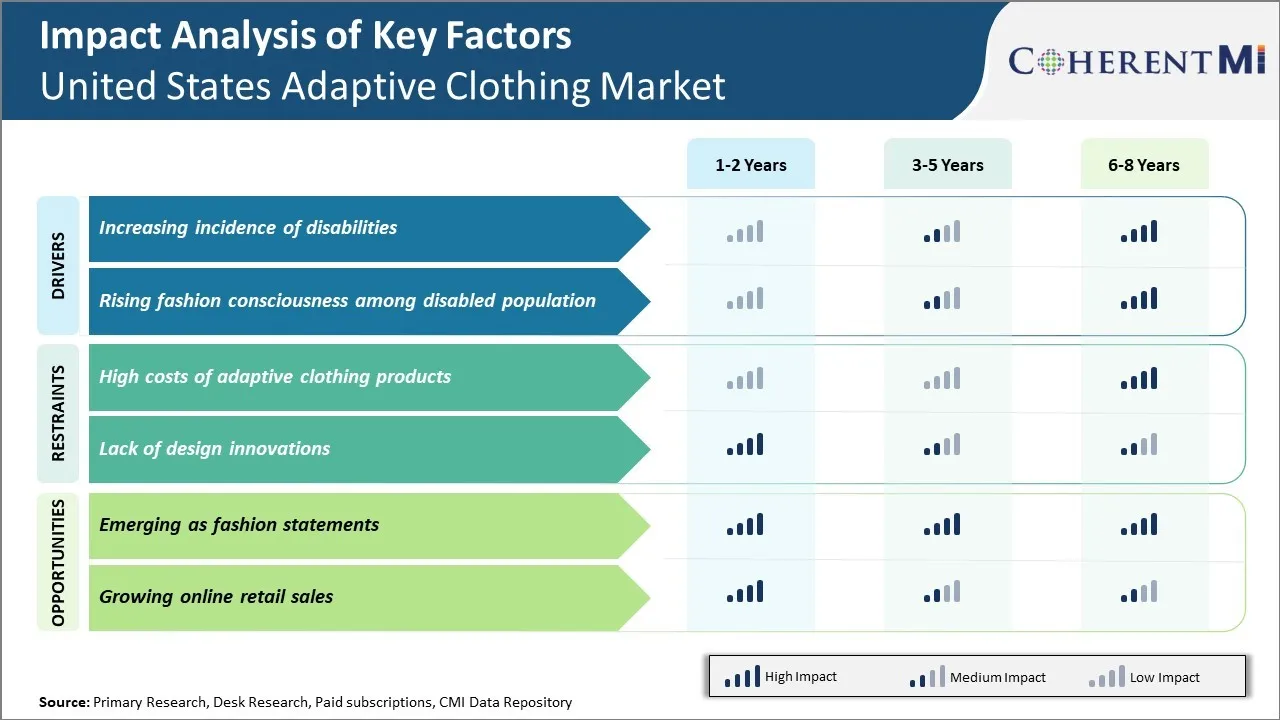United States Adaptive Clothing Market Trends
Market Driver – Increasing Incidence of Disabilities
The increasing incidence of disabilities in the United States is a major factor fueling the growth of the adaptive clothing market. As per data from the Centers for Disease Control and Prevention, over 61 million American adults were living with some form of disability in 2019, which translates to about 26% of the total US population. Of these, mobility disability was the most prevalent type affecting nearly 13% of adults.
The aging population coupled with growing prevalence of chronic medical conditions such as diabetes, arthritis and circulatory system diseases has led to a rise in mobility and physical disabilities over the past decade. As per projections from United Nations Department of Economic and Social Affairs, by 2030 around 20% of the US residents will be aged 65 years and above. With age comes decline in mobility and flexibility, making regular clothing difficult for many elderly people to wear. There is also an increase in learning and developmental disabilities owing to expanding medical diagnosis and improved lifespan of premature infants.
Market Driver – Rising Fashion Consciousness Among Disabled Population
The growing fashion consciousness among people with disabilities in the US is having a significant impact on the adaptive clothing market. As individuals with disabilities are more active, visible and assertive about their rights and needs, they are also expressing their personal style through fashion choices now more than ever before. There is a growing desire among disabled population to dress fashionably and not be limited by their condition or mobility challenges alone.
This rising demand for stylish and trendy adaptive clothing that also accommodates individual needs is fueling innovation in product design. Companies are developing clothes that can be worn discreetly under regular clothes as well as fashion forward styles with accessible features. For example, there is a wide range of dress shirts, pants and jeans now available with hidden zippers, magnetic closures and clasps rather than difficult buttons to allow independence. Adaptive brands are also launching clothing lines with sophisticated fabrics, modern cuts and on-trend colors and prints. With more options that emphasize function along with trendiness, disabled customers feel included and express their unique fashion sense.

Market Challenge – High Costs of Adaptive Clothing Products
The high costs of adaptive clothing products are significantly restraining the growth of the United States adaptive clothing market. Adaptive clothing is specifically designed for people with disabilities and medical conditions to help them get dressed independently and easily. However, due to high production costs involved, the prices of these customized garments are comparatively more than regular apparel. Tailoring clothes to meet the unique needs of individuals with disabilities often requires additional design features, modifications, specialty fabrics and production processes which increase the per unit cost. This makes adaptive clothing financially prohibitive for many potential customers.
Moreover, unlike standard clothing, adaptive garments cannot be mass produced to benefit from economies of scale. Their market demand is also limited owing to the relatively smaller customer base of people with disabilities and medical conditions. This restricted volume further diminishes prospects of bringing down costs through large-scale manufacturing. Due to high pricing, many low-income individuals have to compromise on their dignity and ability to dress independently.
Market Opportunity – Emerging as Fashion Statements
The adaptive clothing market in the United States has seen tremendous growth over the past few years. With greater acceptance and awareness about accessibility and inclusion, adaptive fashion is gaining prominence not just as a basic necessity, but also as a style statement. More and more disabled models are participating in major fashion shows and magazine features, normalizing the idea that adaptive wear can also be trendy and fashionable. This change in perception presents a major business opportunity for brands in this industry.
As adaptive clothing gains acceptance as a valid fashion niche, the customer base is expanding beyond just those with medical or physical needs. Mainstream fashion followers interested in the latest styles are driving significant demand for adaptive looks that are not just functional but attractive. Stylish designs, inclusive sizing, innovative fabrics and thoughtful features allow everyone to enjoy on-trend adaptive outfits. According to a 2020 study by United Spinal Association, nearly 80% of disabled adults surveyed said they would purchase adaptive clothing more frequently if a wider variety of fashionable designs were readily available.